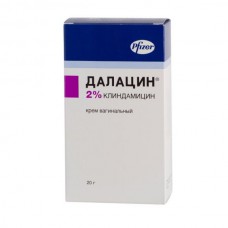Expiration date: 08/2025
The composition and form of issue:
Vaginal suppositories 1 supp.
clindamycin (clindamycin phosphate) 100 mg
excipients: hard fat (Witepsol H-32, a mixture of tri-, di - and monoglycerides)
in strips of 3 PCs in kit with applicator or without the paper cartons 1 package or 1 strip.
Vaginal cream 1 g
clindamycin (clindamycin phosphate) 20 mg
excipients: sorbitane monostearate Polysorbate 60 propylene glycol stearic acid cetostearyl alcohol cetyl palmitate mineral oil benzyl alcohol purified water
in tubes of 20 or 40 g (complete with applicators for 20 g — 3 applicators for 40 g — 7 applicators) in a pack cardboard 1 set.
Description of dosage form:
Vaginal suppositories: solid, torpedo - shaped with a smooth surface of white or almost white.
Vaginal cream: white.
Pharmacokinetics:
Vaginal suppositories. After application of clindamycin intravaginal dose of 100 mg 1 time per day (in the form of suppositories) for 3 days in healthy women of approximately 30% (6-70%) of the administered dose of clindamycin is absorbed into the systemic circulation, while AUC is 3, 2 µg×h/ml (0, 42-11 µg×h/ml).
Serum concentration reaches a maximum after about 5 h (1-10 h) after the introduction of vaginal suppository and is on the 3rd day of therapy on average 0, 27 µg/ml (0, 03-0, 67 µg/ml). Pharmacokinetics of clindamycin does not depend on age.
Vaginal cream. After application of clindamycin intravaginally at a dose of 100 mg/day once (in the form of 2% cream clindamycin phosphate) for 7 days in healthy women the serum concentration reaches its maximum after about 10 h (4-24 h) after the introduction and is the first day averaged 18 ng/ml (4-47 ng/ml), and on the seventh day — 25 ng/ml (6-61 ng/ml), while systemic absorption is about 5% (0, 6-11%) of the administered dose.
In women with bacterial vaginosis, with a similar dosing regimen, about 5% of clindamycin (with a smaller spread of 2-8%) is absorbed, the serum concentration reaches its maximum approximately 14 hours (4-24 hours) after administration and averages 13 ng/ml (6-34 ng/ml) on the first day, and 16 ng/ml (7-26 ng/ml) on the seventh day.
After intravaginal administration of repeated doses, clindamycin is almost not cumulated in the blood. The system half-life period is 1, 5-2, 6 hours.
Description of the pharmacological action:
Clindamycin phosphate is inactive in vitro, but rapidly hydrolyzed in vivo to form clindamycin, which has antibacterial activity. Clindamycin inhibits protein synthesis in the microbial cell by interaction with the 50S ribosome subunit, has a bacteriostatic effect, and at higher concentrations against some microorganisms — bactericidal.
In vitro, the following microorganisms causing bacterial vaginosis are sensitive to clindamycin: Gardnerella vaginalis, Mobiluncus spp., Mycoplasma hominis, Bacteroides spp., Peptostreptococcus spp.
Indications:
Bacterial vaginosis.
Contraindications:
Hypersensitivity to clindamycin, lincomycin or any component of the drug.
Application during pregnancy and breast-feeding:
When using clindamycin intravaginal in the II or III trimester of pregnancy, there was no increase in the frequency of congenital fetal abnormalities. If Dalacin suppositories vaginal (although official studies on the use of suppositories in pregnant women have not been carried out) or vaginal cream is used during the II or III trimesters of pregnancy, the adverse effect on the fetus is unlikely. Adequate controlled studies on the use of the drug in the first trimester of pregnancy was not carried out, so Dalacin suppositories vaginal or vaginal cream can be prescribed to women in the first trimester of pregnancy only on absolute indications, i.e. when the potential benefit of therapy with the drug exceeds the potential risk to the fetus.
It is unknown whether clindamycin is released into breast milk after intravaginal use. Clindamycin was found in breast milk after oral or parenteral administration, therefore, when deciding on the possibility of prescription of clindamycin in the form of vaginal suppositories or vaginal cream during breastfeeding, it is necessary to assess the expected potential benefit of therapy with the drug and the possible risk to the child.
Side effect:
The frequency of occurrence of the side effects listed below is less than 10%.
With the genitourinary system: both dosage forms — irritation of the mucous membrane of the vulva and vagina, pain in vagina, vaginal candidiasis, menstrual disorders, vaginal discharge, dysuria, pyelonephritis, vaginal infection cream vaginal additionally vulvovaginitis, Trichomonas vaginitis, uterine bleeding, urinary tract infection, abnormal labor, endometriosis, glycosuria, proteinuria.
From the body as a whole: for both dosage forms, fungal infection, localized abdominal pain, abdominal cramps, headache, generalized pain for vaginal suppositories — fever, pain in the side for vaginal creams generalized abdominal pain, bacterial infection, lower abdominal pain, halitosis, inflammatory swelling, upper respiratory tract infection, back pain, bloating, rejecting the results of microbiological tests from the norm, allergic reactions.
From the blood: for vaginal suppositories — diarrhea, nausea, vomiting vaginal cream constipation, dyspepsia, flatulence, gastrointestinal disorder, taste perversion.
On the part of the skin and mucous membranes: for both dosage forms — rash, itching at the site of administration for vaginal suppositories — itching, pain for vaginal cream — itching (not at the site of administration), macular rash, erythema, candidiasis (skin), urticaria.
For vaginal cream additionally
From the Central nervous system: dizziness.
From the endocrine system: hyperthyroidism.
From the respiratory system: nasal bleeding.
Drug interaction:
For both dosage forms. No interactions were observed in pharmacodynamic, pharmacokinetic or clinical studies of these dosage forms. Since information about the use of other drugs for intravaginal administration is not available, the joint application with other drugs for intravaginal administration is not recommended.
For vaginal suppositories. It is established that with systemic use clindamycin violates neuromuscular transmission, so it can enhance the effect of other peripheral-acting muscle relaxants.
For vaginal cream. There is a cross-resistance between clindamycin and lincomycin. In vitro antagonism between clindamycin and erythromycin was demonstrated.
Method of application and doses:
Intravaginally, preferably at bedtime (horizontal) to 1 supp. within 3 consecutive days or one complete applicator (5 g of cream — 100 mg of clindamycin phosphate) for 3 or 7 consecutive days.
Guidelines for the use of suppositories
A. doing suppositories without applicator.
1. Remove the suppository from the foil.
2. In the supine position pull your knees to your chest.
3. Carefully insert the suppository into the vagina using the middle finger as deeply as possible.
B. maintenance of the suppository using the applicator.
1. Plastic applicator, located in a package with the drug, designed to facilitate the introduction of the suppository into the vagina.
2. Remove the suppository from the foil.
3. Place the flat end of the suppository into the applicator opening.
4. In the supine position pull your knees to your chest.
5. Holding the applicator horizontally behind the ribbed end of the body, carefully insert it into the vagina as deeply as possible.
6. By pushing the plunger slowly, to introduce a suppository in the vagina.
7. Carefully remove the applicator from the vagina.
8. After each use the applicator should be washed with warm soapy water and give it to dry completely.
Guidance on the use of vaginal cream
In the package with 20 g of cream is 3 plastic applicators, in the package with 40 g-7 applicators designed for proper administration of cream into the vagina.
1. Remove the cap of the tube with cream. Screw the plastic applicator onto the threaded neck of the tube.
2. Rolling the tube from the opposite end, gently squeeze the cream into the applicator (the applicator is filled when its piston reaches the stop).
3. Unscrew the applicator from the tube and wrap the cap.
4. In the supine position pull your knees to your chest.
5. Holding the applicator horizontally, carefully insert it into the vagina as deeply as possible, without causing discomfort.
6. Slowly pressing the piston until it stops, enter the cream into the vagina.
7. Carefully remove the applicator from your vagina and throw it away.
Overdose:
Dalacin vaginal suppositories and vaginal cream is intended for intravaginal use only. About to overdose have been reported.
Symptoms: accidental ingestion of the drug in the gastrointestinal tract can cause systemic effects similar to those that occur after taking clindamycin inside in therapeutic doses.
Treatment: symptomatic and supportive. Not excreted by hemodialysis and peritoneal dialysis.
Special instruction:
Prior to the appointment of the drug using appropriate laboratory methods should be excluded Trichomonas vaginalis, Chlamydia trachomatis, N. gonorrhoeae, Candida albicans and Herpes simplex virus often causing vulvovaginitis.
Intravaginal use of clindamycin can lead to increased growth of insensitive microorganisms, especially yeast-like fungi.
The use of clindamycin (as well as almost all antibiotics) inside or parenterally associated with the development of severe diarrhea and in some cases — pseudomembranous colitis. With the development of severe or prolonged diarrhea, the drug should be abolished and, if necessary, appropriate diagnostic and therapeutic measures should be taken.
Patients should be warned that during therapy with the drug should not enter into sexual intercourse, as well as use other means for intravaginal administration (tampons, douching).
The drug contains components that can reduce the strength of latex or rubber products, so the use of condoms, vaginal diaphragm and other latex products for intravaginal use during therapy with the drug is not recommended.
Effects on ability to drive a car or operate machinery. There is no reason to believe that the use of the drug Dalacin vaginal suppositories and vaginal creams can have an impact on the ability to drive a car or operate machinery.




